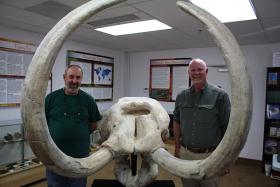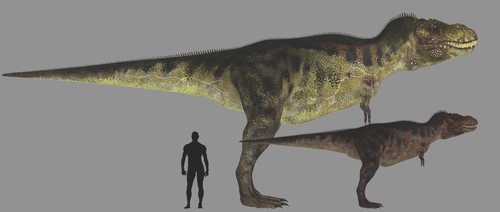By Jessica Robinson, NW News Network
A group in the Boise area is in the midst of fundraising for a new attraction in the Northwest. It’ll be called the Northwest Science Museum.

They envision a 350,000-square-foot space full of fossils, rocks and animal specimens. But this isn’t your usual natural history museum. It’s designed by creationists.
Most scientists, textbooks, and natural history museums would tell you the Earth is several billion years old, that plant and animal species evolved over time, and that dinosaurs died out millions of years before our human ancestors appeared. You might even take that as a given. But a large segment of the population believe something else happened.
It’s the story Doug Bennett wants to tell in the museum.
Creationist view
“The first thing you’re going to see as you walk up to the building is a full-scale Noah’s Ark,” Bennett pointed out.
That ark, and Noah’s flood, are key to the way Bennett sees the history of the earth. To him, it explains many of the geological formations and how fossils were distributed. Bennett is among the 42 percent of Americans who have a creationist view of the world. He believes the earth and all life were created in their present form in one week, about 6,000 years ago.
To Bennett, evolution isn’t about science, it’s about morality.
“If you can make up a system that says there is no god, that things just happen by chance, then we’re not accountable to any higher being,” he said. “And so you can do what you want and have no consequence.”
So far, Bennett and the other founders have set up a smaller version of what they hope to build – they call it the Vision Center. They’ve rented a space in a business park at the edge of Boise and put in displays, including a huge mastodon skull whose tusks fill the center of the room.
‘The most controversial stones in the world’
Bennett said the idea for the museum was an inspiration from God.

“I think everybody needs to see the evidence we will have in the museum,” he added. “One of the things we have here in this vision center is probably the most controversial stones in the world. Because they show man and dinosaurs interacting.”
In one of the glass cases, Stan Lutz, one of the other founders, pointed out a collection of “Ica stones,” which he said are ancient stones from Peru.
“This stone right here, you can see there’s a man on it riding on a triceratops dinosaur,” he said.
Lutz pointed to a tan colored stone with a man on a lizard-like creature.
“We have rocks showing at least 14 species of dinosaur that are all accurately drawn,” he said.
This isn’t the only evidence they’ll display. In fact, Bennett said they’ll even show the argument from the other side, what he calls the “naturalistic perspective.”
“We want to bring that out and say, ‘Ok, people. Let’s make your choice here.’ Don’t just believe because you’re being told that. Think for yourself. Use critical thinking and think, does this make sense?” Bennett said. “Or is it better to believe what the Bible says — that God created all things.”
The museum in Idaho joins at least a dozen creation museums in other states trying to provide a counterweight to prevailing scientific thought. One museum near Mt. Saint Helens uses the mountain’s explosion as proof that the earth can change rapidly. This year, the Creation Museum in Kentucky hosted a much-discussed debate between the museum’s founder and science personality Bill Nye.
Creationism vs intelligent design
But Casey Luskin, from the Discovery Institute in Seattle, said in many ways, the real debate has moved on.
“I definitely think the conversation about origins has shifted a lot, over the last probably 15 or so years,” he said.
The Discovery Institute is one of the main proponents of intelligent design. Like creationism, intelligent design says the complexity of life was directed by some sort of intelligent cause. But beyond that Luskin draws a sharp line between intelligent design and creationism.
“Intelligent design starts with the data. Whereas creationism starts with the Bible,” he explained. “Intelligent design doesn’t say the earth is 6,000 years old, whereas creationism — that’s a major claim that creationists will make. And so, when people conflate the two, it’s an attempt to try to dismiss the arguments for design in nature without actually addressing them.”
On a visit to the museum’s Vision Center, Laura Wallace of nearby Nampa browsed the displays and found herself divided — between two different views of the history of the earth.
“I don’t know, I mean I believe God could do either,” she said. “If he wanted to do it in a million years he could have. Or if he wants to do it in 4,000 years he could do it. So I don’t know — I guess I’m kind of waffling. I don’t really have a definitive answer on that, but that’s ok, sometimes you don’t have all the answers either.”
Maybe not. But the founders of the museum want to give her a place to look.


 Nanuqsaurus, the North’s new “pygmy” dinosaur, was announced to much hoopla this spring, when fragments from a 2006 excavation in Alaska were identified in a recent report as a separate, smaller Tyrannosaurus species. But not much smaller. Despite the fact that Nanuqsaurus was a) half the size of his regal relatives, and b) likely covered in a coat of downy feathers, the 70-million-year-old reptile was still six metres from head to toe, able to comfortably snack on even the largest modern polar bear.
Nanuqsaurus, the North’s new “pygmy” dinosaur, was announced to much hoopla this spring, when fragments from a 2006 excavation in Alaska were identified in a recent report as a separate, smaller Tyrannosaurus species. But not much smaller. Despite the fact that Nanuqsaurus was a) half the size of his regal relatives, and b) likely covered in a coat of downy feathers, the 70-million-year-old reptile was still six metres from head to toe, able to comfortably snack on even the largest modern polar bear.